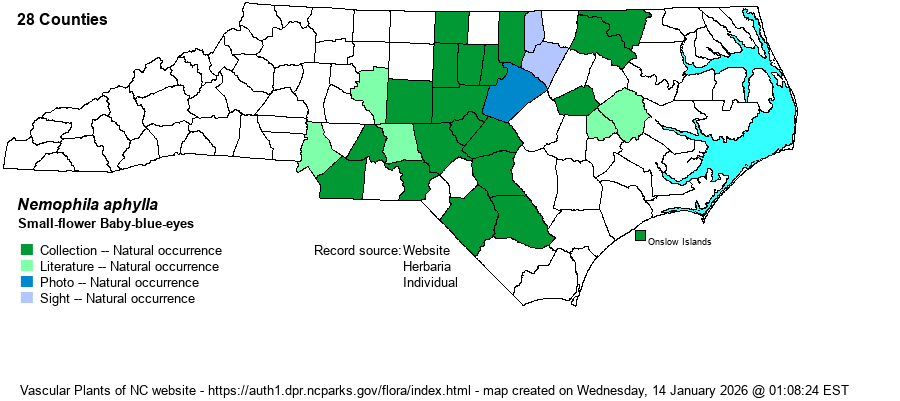| Author | (L.) Brummitt | |
| Distribution | Present over most of the eastern third of the Piedmont, west to Caswell, Davidson, and Mecklenburg counties. Ranges east into the upper Coastal Plain (but avoiding the Sandhills region), but there essentially only along a few brownwater river floodplains (i.e., Roanoke and Cape Fear). The disjunct population in Onslow County was found by Ritchie Bell in 1972 on Topsail Island, growing with Aesculus pavia. The range is spreading in recent years, perhaps as siltation is increasing in floodplains, even in smaller creek floodplains.
This species has some disjunctions in its somewhat wide Southern range. It ranges north to MD and extreme southern IL, and south to western FL and eastern TX. However, it is absent from much of the middle and upper Piedmont province and the Appalachians. Thus, populations from MD to SC are somewhat fragmented from the larger part of the range from TN and AL westward. | |
| Abundance | Quite local, but common to abundant along a few brownwater river floodplains -- mainly the Roanoke, the Deep, and the Cape Fear, and much less so along the Tar and Neuse rivers and tributaries. Scarce but increasing away from such places. | |
| Habitat | This species grows only on very nutrient-rich floodplain soils and adjacent lower slopes. It grows on natural levee forests, rich bottomland forests, and Basic Mesic Forests (lower slopes). It is strongly colonial, occurring in huge stands, but these habitats are also excellent habitat for a number of exotic species that compete with it and can smother it -- Microstegium vimineum, Stellaria media, and others. |
| Phenology | Blooms in March and April, and fruits soon after flowering. It is a spring ephemeral species, disappearing from above-ground by later in May, not to reappear until early the next year. | |
| Identification | This is a very small, weak-stemmed herb that almost forms mats owing to its weakness. It has a stem only about 6-8 inches long, with much branching. It has a few alternate leaves, each leaf divided into 3-5 lobes or segments, but only about 1-inch long. From many of the leaf axils grow a single very small white flower on a moderate stalk. This flower is bell-shaped, with 5 spreading lobes, but only about 1/8-inch across. The plant tends to have a bright grass-green to chartreuse color, as opposed to the quite similar Phacelia covillei, which may often grow with it. That species has blue-green leaves that are longer and are more strongly pinnately cut into 3-7 segments, often with purple dots along the leaf margins. Also, it has light blue to lavender and more tubular flowers, though still just as tiny at about 1/8-inch long. Each of these two species grows in dense stands, so much so that it can be difficult to count individuals and see where one plant stops and another begins. | |
| Taxonomic Comments | This species has often been named as Nemophila microcalyx.
| |
| Other Common Name(s) | Eastern Baby-blue-eyes | |
| State Rank | S4 | |
| Global Rank | G5 | |
| State Status | | |
| US Status | | |
| USACE-agcp | FACW link |
| USACE-emp | FACW link |

